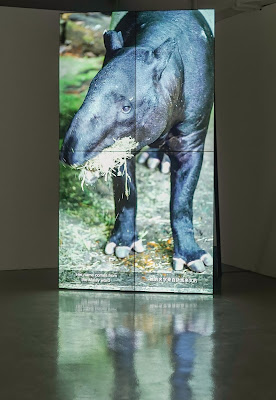黑與白-馬來貘 Black and White - Malayan Tapir
四頻道錄像裝置 four-channel video installation,6'55",2018
The development in Southeast Asia progressed when the British East India Company chose Singapore as a commercial base and started its modernisation. As commercial development took place in Singapore, Europe also rapidly began to gather data and initiate the study of plants and animals, also the establishment of museums. William Farquhar, the first commandant of the British East India Company in Malacca, hired a Chinese painter to do large-scale mapping and sorting of species in the Malay Peninsula. As a result, a black and white creature, Malayan tapir, was recorded.
Due to the rapid development of biology, the naming and data recording of animals and plants became a competitive field for many naturalists. However, Thomas Stamford Raffles, the commandant of the British East India Company in Penang, and William Farquhar, the commandant in Malacca, stayed engaged in political competition and started scientific disputes. Their recorded collection of animals and plants at the time was shipped from place to place during the colonial era until it returned to Singapore to the National Heritage Board.
Black and White – Malayan Tapir hopes to apply an encyclopedic narrative style to deal with the equality between people and non-humans, as well as man and nature while exploring the changes regarding how modern people view images. The scenes switch from the National Gallery Singapore, the National History Museum, and Singapore Zoo to search engines and multiple windows. The political relationship between the zoo's history in Southeast Asia and the colonial era leads to the drawing of a scientific illustration, biology, civil division, and the local legend of Malayan tapir.
英國東印度公司在東南亞開發之際,選擇新加坡作為商業的據點,開始了當地的現代性建設。商業開發的同時,歐洲也同時快速發展動植物學與博物館的資料搜集與建構。英國東印度公司派任麻六甲的第一任司令威廉・法夸爾(William Farquhar)曾雇用中國畫師,針對馬來西亞的物種做大規模的繪製與整理,因而記錄了一種黑白生物:馬來貘。
在生物學迅速發展的時代,動植物的命名與資料記錄成為眾多生物愛好者相互競爭的範疇。然而,英國東印度公司的檳城司令萊佛士(Thomas Stamford Raffles)與麻六甲司令威廉・法夸爾,從政治的競爭關係延燒到科學的紛爭。他們當時候的動植物紀錄收藏歷經殖民時代的海上移動,輾轉回到新加坡,收藏在新加坡國家文物局。
《黑與白-馬來貘》希望從百科全書式的敘事方式處理一種人與非人,人與自然之間,一種平等非主從的關係,並探討現代人觀看影像的方式變化。畫面在新加坡國家美術館、自然科學博物館、新加坡動物園、搜尋引擎與多重視窗的場景間移動,開展出東南亞地區的動物園歷史與殖民時代的政治關係,繼而牽引出科學繪畫、生物學、城市區域劃分與馬來貘在當地的傳說。
The development in Southeast Asia progressed when the British East India Company chose Singapore as a commercial base and started its modernisation. As commercial development took place in Singapore, Europe also rapidly began to gather data and initiate the study of plants and animals, also the establishment of museums. William Farquhar, the first commandant of the British East India Company in Malacca, hired a Chinese painter to do large-scale mapping and sorting of species in the Malay Peninsula. As a result, a black and white creature, Malayan tapir, was recorded.
Due to the rapid development of biology, the naming and data recording of animals and plants became a competitive field for many naturalists. However, Thomas Stamford Raffles, the commandant of the British East India Company in Penang, and William Farquhar, the commandant in Malacca, stayed engaged in political competition and started scientific disputes. Their recorded collection of animals and plants at the time was shipped from place to place during the colonial era until it returned to Singapore to the National Heritage Board.
Black and White – Malayan Tapir hopes to apply an encyclopedic narrative style to deal with the equality between people and non-humans, as well as man and nature while exploring the changes regarding how modern people view images. The scenes switch from the National Gallery Singapore, the National History Museum, and Singapore Zoo to search engines and multiple windows. The political relationship between the zoo's history in Southeast Asia and the colonial era leads to the drawing of a scientific illustration, biology, civil division, and the local legend of Malayan tapir.
英國東印度公司在東南亞開發之際,選擇新加坡作為商業的據點,開始了當地的現代性建設。商業開發的同時,歐洲也同時快速發展動植物學與博物館的資料搜集與建構。英國東印度公司派任麻六甲的第一任司令威廉・法夸爾(William Farquhar)曾雇用中國畫師,針對馬來西亞的物種做大規模的繪製與整理,因而記錄了一種黑白生物:馬來貘。
在生物學迅速發展的時代,動植物的命名與資料記錄成為眾多生物愛好者相互競爭的範疇。然而,英國東印度公司的檳城司令萊佛士(Thomas Stamford Raffles)與麻六甲司令威廉・法夸爾,從政治的競爭關係延燒到科學的紛爭。他們當時候的動植物紀錄收藏歷經殖民時代的海上移動,輾轉回到新加坡,收藏在新加坡國家文物局。
《黑與白-馬來貘》希望從百科全書式的敘事方式處理一種人與非人,人與自然之間,一種平等非主從的關係,並探討現代人觀看影像的方式變化。畫面在新加坡國家美術館、自然科學博物館、新加坡動物園、搜尋引擎與多重視窗的場景間移動,開展出東南亞地區的動物園歷史與殖民時代的政治關係,繼而牽引出科學繪畫、生物學、城市區域劃分與馬來貘在當地的傳說。





沒有留言:
發佈留言